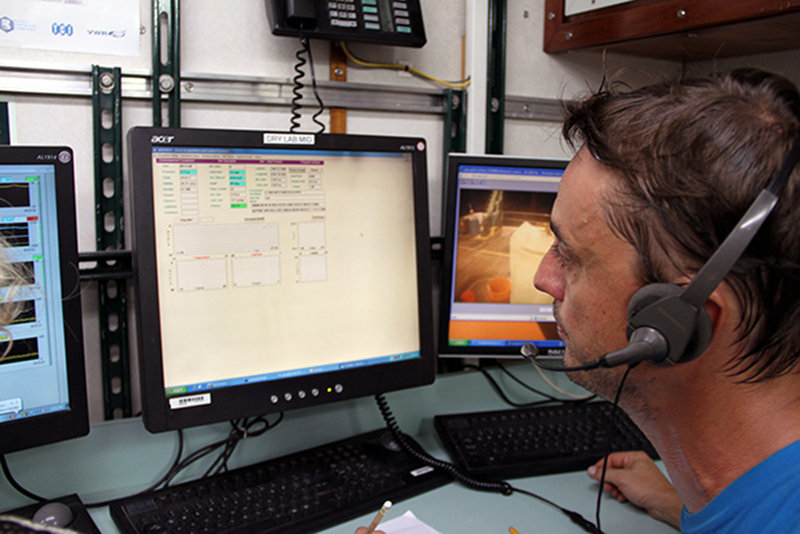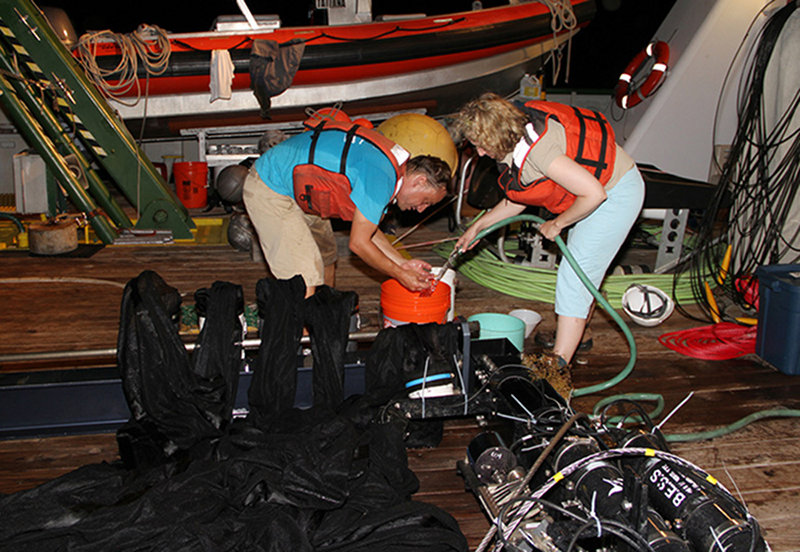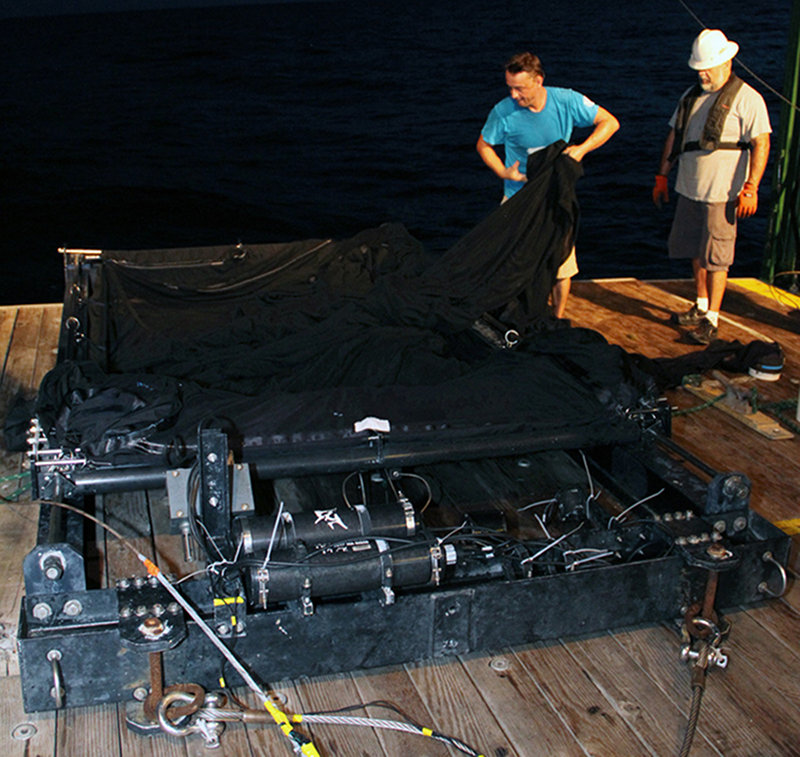
By M. Dennis Hanisak, Chief Scientist for Coral Reef Connectivity 2013 Cruise, and Research Professor - FAU Harbor Branch
August 25, 2013

Cedric Guigand, University of Miami, tosses one of the 5 cod-ends attached to the MOCNESS over the stern of the R/V Walton Smith. It will concentrate the many planktonic organisms gathered up by one of the nets opened at a particular depth. Image courtesy of M. Dennis Hanisak, FAU Harbor Branch. Download larger version (jpg, 573 KB).
One of the tools we have on the RV Walton Smith for this cruise has the intriguing name of MOCNESS, possibly a play on Loch Ness, and its mythical monster. MOCNESS is the acronym for Multiple Opening/Closing Net and Environmental Sensing System, a net system consisting of up to ten nets attached to a square frame that is used to collect plankton (small drifting organisms) and small nekton (larger, freely swimming organisms such as fish) in the ocean. The MOCNESS enables biologists to sample these organisms in various depth horizons during one trawl rather than more familiar plankton nets, which tow only at one range of depths. This greater resolution of depth distribution can be very helpful to understanding the community structure of the water column.

Nets of the MOCNESS trawl are triggered to open and close from a computer in the ship’s lab. The screens display a variety of environmental parameters including temperature and depth from the MOCNESS. Image courtesy of Brian Cousin, FAU Harbor Branch. Download larger version (jpg, 668 KB).
During this cruise, Cedric Guigand (University of Miami) and Kimberly Puglise (NOAA), with excellent assistance by the crew of the Walton Smith, have done five deployments of UM’s MOC4, which has nets that are each 4 m2 and have mesh openings of 800 µm. That size is appropriate to collect larval fish; most zooplankton are smaller and will pass through the mesh. The frame is attached to conducting wire that transmits information from sensors on the net frame back to the surface. The opening and closing of the nets are controlled by Cedric at a computer in the dry lab of the ship. The five nets we are using on the MOC4 each sample a discrete range of water depths. For example, in 100 meters depth they would be programmed to open and then close at intervals of 20 meters. The MOC 4 includes sensors to measure salinity and temperature at the sampling depths.

Cedric Guigand (UM) and Kimberly Puglise (NOAA) rinse one of the MOCNESS nets with seawater to flush the contents into the plastic cod-end for collection. Image courtesy of Brian Cousin, FAU Harbor Branch. Download larger version (jpg, 938 KB).
We have trawled over sites at both Pulley Ridge and the Tortugas area and always a couple of hours after the sun goes down. The MOCNESS is towed for 45 minutes behind the ship at a speed of about 2 knots. Each net has a collection bucket attached to it called a cod-end which concentrates the organisms retained by the net. Upon retrieval, the MOCNESS is brought back onboard and the contents of the cod-ends are emptied and rinsed through sieves, and preserved in alcohol for analysis back in the lab.

The MOCNESS is a large, heavy system used for capturing some of the smallest, most fragile organisms in the ocean. The University of Miami MOC4 is ready to be picked up by the A-frame of the R/V Walton Smith and manuevered over the stern and into the dark water. Image courtesy of Brian Cousin, FAU Harbor Branch. Download larger version (jpg, 877 KB).
The analyses of these samples, along with those Cedric is collecting with the larval light traps on this cruise combined with previous collections and data on these reefs, will allow the Pulley Ridge Team to determine patterns of recruitment of valuable fish species , and be an important component of the connectivity models that will be developed as part of this project. So despite its name, the MOCNESS is not a monster, but a valuable tool in our research!